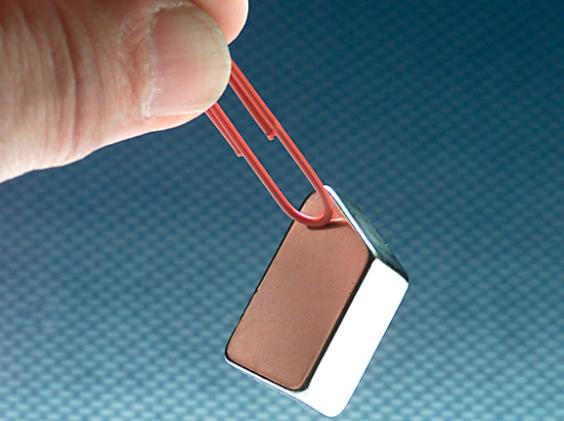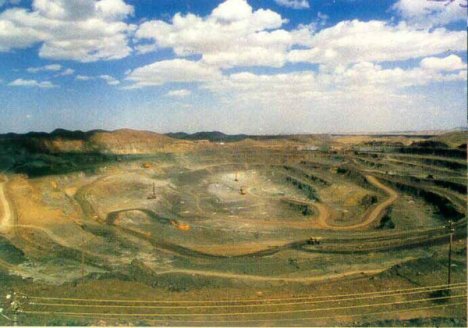Mining those rare earth elements destroys nature:
– Earth-Friendly Elements, Mined Destructively (New York Times)
Neodymium is one of 17 metals crucial to green technology. There’s only one snag – China produces 97% of the world’s supply. And they’re not selling

A neodymium magnet, commonly used in motors, loudspeakers and other appliances. Neodymium is a rare earth element
Britain and other Western countries risk running out of supplies of certain highly sought-after rare metals that are vital to a host of green technologies, amid growing evidence that China, which has a monopoly on global production, is set to choke off exports of valuable compounds.
Failure to secure alternative long-term sources of rare earth elements (REEs) would affect the manufacturing and development of low-carbon technology, which relies on the unique properties of the 17 metals to mass-produce eco-friendly innovations such as wind turbines and low-energy lightbulbs.
China, whose mines account for 97 per cent of global supplies, is trying to ensure that all raw REE materials are processed within its borders. During the past seven years it has reduced by 40 per cent the amount of rare earths available for export.
Industry sources have told The Independent that China could halt shipments of at least two metals as early as next year, and that by 2012 it is likely to be producing only enough REE ore to satisfy its own booming domestic demand, creating a potential crisis as Western countries rush to find alternative supplies, and companies open new mines in locations from South Africa to Greenland to satisfy international demand.
Amid claims that Beijing is using its rare earths monopoly as a tool of foreign policy, the British Department of Business, Industry and Skills said it was “monitoring” the supply of REEs to ensure China was observing international trade rules.
Jack Lifton, an independent consultant and a world expert on REEs, said: “A real crunch is coming. In America, Britain and elsewhere we have not yet woken up to the fact that there is an urgent need to secure the supply of rare earths from sources outside China. China has gone from exporting 75 per cent of the raw ore it produces to shipping just 25 per cent, and it does not consider itself to be under any obligation to ensure supplies of rare earths to anyone but itself. There has been an effort in the West to set up new mines but these are five to 10 years away from significant production.”
After decades in which they were considered little more than geological oddities, rare earths have recently become a boom industry after the invention of a succession of devices, including iPhones and X-ray machines, which rely on their specific properties.
Global demand has tripled from 40,000 tonnes to 120,000 tonnes over the past 10 years, during which time China has steadily cut annual exports from 48,500 tonnes to 31,310 tonnes.
Worldwide, the industries reliant on REEs, which produce anything from fibre-optic cables to missile guidance systems, are estimated to be worth £3 trillion, or 5 per cent of global GDP.
Beijing announced last month that it was setting exports at 35,000 tonnes for each of the next six years, barely enough to satisfy demand in Japan. From this year, Toyota alone will produce annually one million of its hybrid Prius cars, each of which contains 16kg of rare earths. By 2014, global demand for rare earths is predicted to reach 200,000 tonnes a year as the green revolution takes hold.
Nearly all of China’s supply of rare earths comes from a single mine near the city of Baotou, in Inner Mongolia. The remainder comes from small and sometimes illegal mines in the south of the country, leading to devastating pollution from the poisonous and sometimes radioactive ores.
Environmentalists argue that this, coupled with widespread criticism of China’s stance during the Copenhagen climate summit, adds to the need for a “plurality” of rare earth resources. One campaigner said: “There are legitimate questions over Beijing’s control of these resources. Copenhagen showed they are not above putting national interest ahead of global efforts to curtail global warming.”
Once extracted and refined, the rare earth metals can be put to a dizzying range of hi-tech uses. Neodymium, one of the most common rare earths, is a key part of neodymium-iron-boron magnets used in hyper-efficient motors and generators. Around two tonnes of neodymium are needed for each wind turbine. Lanthanum, another REE, is a major ingredient for hybrid car batteries (each Prius uses up to 15kg), while terbium is vital for low-energy light bulbs and cerium is used in catalytic converters.
In October, an internal report by China’s Ministry of Industry and Information Technology disclosed proposals to ban the export of five rare earths and restrict supplies of the remaining metals. Beijing strenuously denied that the document was an accurate reflection of its strategy, saying it had no desire to reduce trade in rare earths. But The Independent understands that the level of demand in China means that supplies of at least two crucial REEs – terbium and dysprosium – are likely to be curtailed by as early as next year.
Dr Ian Higgins, general manager of Birkenhead-based Less Common Metals, which specialises in rare earth products, said: “There is a threat that in the next 12 to 18 months, there might be some quite severe shortages of these rare earths. That is certainly going to impact those hi-tech green industries outside China.”
Both Western countries and China are already dashing to secure new sources of rare earths. Last year, Australian regulators imposed restrictions on the purchase of one of the country’s richest rare earth mines, causing a Chinese company to walk away from a £400m deal to buy its operator.
European and North American companies are meanwhile racing to open or re-open mines in Canada, South Africa and Greenland amid calls in the US for government-backed loans to secure supplies of some REEs which are used in the guidance systems of missiles and laser-guided munitions. Toyota has effectively bought its own rare earth mine in Vietnam by signing an exclusive supply deal.
The Department for Business, Industry and Skills acknowledged the growing concern in Western capitals. A spokesman said: “We are monitoring the situation, particularly with regard to World Trade Organisation rules. We are working with UK industry to assess the long-term demand for strategically important resources, including rare earth elements.”
By Cahal Milmo
Saturday, 2 January 2010
Source: Bloomberg

3 thoughts on “China clamps down on exports of rare earth elements crucial to green technology”